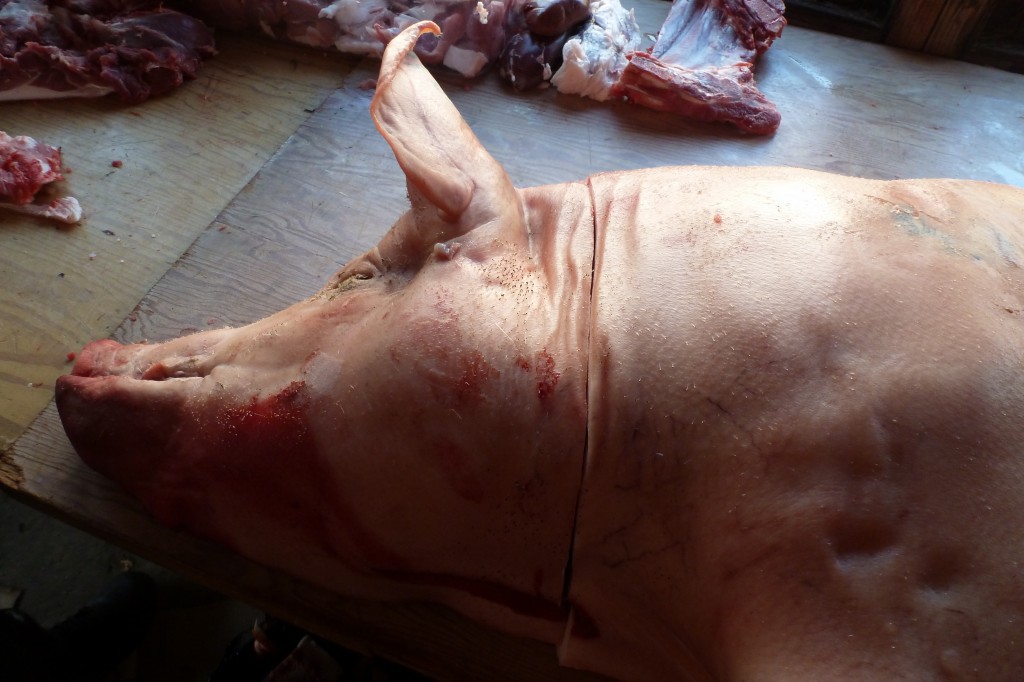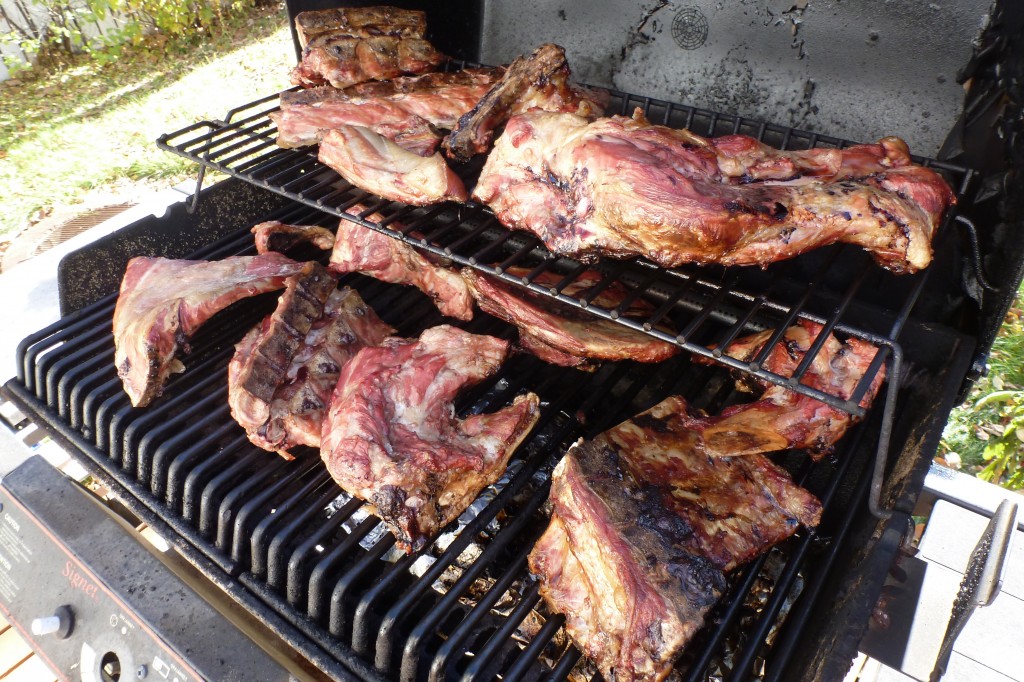Everybody rejoices when November kills its pig.
-an inscription on the Münster Cathedral
 Edmonton gets cold enough to butcher outdoors a bit sooner than Westphalia, so our version of the inscription would have October killing the hog.
Edmonton gets cold enough to butcher outdoors a bit sooner than Westphalia, so our version of the inscription would have October killing the hog.
This year Lisa and I bought a side of pork from Nature’s Green Acres. I cut up our meat at Kevin’s, on what he and his family call Pig Day. While the majority of the pork was wrapped and frozen, there was also some curing, smoking, and grinding, processes that have come to typify the season.
Brine-Curing
Processing a side of pork is made less daunting by the presence of a brine bucket. Certain pieces can go straight from the cutting board to the brine, making for less wrapping, labelling, and freezer management.
There are two types of brines. The first contains only table salt and other flavours like brown sugar and herbs. Salt is absorbed into the meat so that it is seasoned throughout its mass, and not just on the outside. The meat will retain more moisture during cooking. I call this a “seasoning brine.” This is a relatively quick process: I might brine a thick pork chop for four hours before cooking it.
If sodium nitrite is added to the brine, some additional, complex chemical changes occur. The meat develops a vibrant pink colour and a piquant flavour. I call this a “curing brine,” to contrast it with the seasoning brine explained above. The curing brine takes longer than the seasoning brine.
Seasoning brines are typically made the day that you cook the meat. Curing brines can be started the day that the pig is fabricated. Cuts that are typically brine-cured include hocks, hams, eye of loin (Canadian bacon), and the tongue.
Dry-Curing
Other cuts are better cured in a dry rub. This is especially true of fatty pieces like the jowl and the belly. These cuts get mixed with the dry cure (salt, curing salt, sugar, herbs), then bagged and left in the fridge for a week, after which they are rinsed and either air-dried or hot-smoked.
Grinding Meat and Making Sausages
When I first started cutting my pig, I assumed that all the trim would supply ample meat and fat for grinding. This may be true of professional butcher shops that produce portion-controlled chops with clean bones, but when the pig is separated mostly into large roasts, there is actually very little trim. A portion of the shoulder must be specially reserved for ground meat. I shoot for a 3:1 ratio of meat to fat.
I store my ground meat in three forms. First there are one pound bags of ground pork, unseasoned, ready to be made into patties or pie filling. I also find it handy to freeze some loose ground pork that has already been seasoned and spiced. Finally there are sausages.
Rendering Fat to make Lard
We keep a lot of fat on the roasts and steaks, so we set aside a section of back fat especially for rendering. There is also the leaf lard, the brittle fat around the kidneys, analogous to the suet in sheep and cows. All the fat is thrown in a heavy stainless steel pot with bit of water and put over very, very low heat. The water helps distribute the heat in the early stage of the rendering. Eventually the water evaporates, but by that time enough fat has melted to serve the same function. I typically leave my fat on the stove overnight.
Making Stock
Even with many of the bones staying in roasts (the hocks, trotters, rib roast, hams…), there are still plenty left to make stock. Sections of the backbone, as well as the riblets, skull, tailbone, shoulder blade, and arm bone are lightly smoked on the barbecue, thrown in a pot, covered with cold water, brought to a boil, then simmered for twenty four hours. The next day I add the vegetables and simmer for an hour, then the herbs, which are simmered for fifteen minutes.
Finally the stock is strained and cooled, then frozen into ice cube trays so that it can be used a little at a time.
